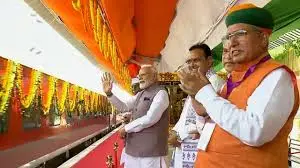PM Modi inaugurates 103 railway stations under Amrit Bharat Station Scheme

In a landmark event aimed at revolutionizing India’s railway infrastructure, Prime Minister Narendra Modi inaugurated 103 redeveloped railway stations on May 22, 2025, under the Amrit Bharat Station Scheme (ABSS). This mega initiative represents a bold step toward creating smart, sustainable, and culturally vibrant transportation hubs across the nation.
What is the Amrit Bharat Station Scheme?
The Amrit Bharat Station Scheme, introduced by the Ministry of Railways in 2023, is a visionary plan to redevelop more than 1,300 railway stations across India. Rather than applying a one-size-fits-all model, the scheme focuses on customizing station upgrades based on passenger volume, local heritage, and regional priorities.
The scheme targets both infrastructure transformation and passenger experience enhancement, integrating modern technology with regional aesthetics. The core objectives include:
- Upgraded passenger amenities such as air-conditioned waiting halls, digital information systems, and modern restrooms.
- Integration of green technologies like solar energy systems and rainwater harvesting.
- Enhanced accessibility features for differently-abled passengers and senior citizens.
- Celebration of local culture and heritage through architecture and design elements.
Scope of the Inauguration
The 103 stations inaugurated in May 2025 span across 86 districts and 18 states and Union Territories, emphasizing equitable infrastructure development throughout India. Each station is designed to become a gateway that reflects the identity and pride of its location.
Breakdown by State:
- Uttar Pradesh – 19 stations
- Gujarat – 18 stations
- Maharashtra – 15 stations
- Tamil Nadu – 9 stations
- Rajasthan – 8 stations
- Madhya Pradesh – 6 stations
- Karnataka and Chhattisgarh – 5 stations each
- Jharkhand, Telangana, West Bengal – 3 stations each
- Bihar and Kerala – 2 each
- Assam, Andhra Pradesh, Haryana, Himachal Pradesh, Puducherry – 1 station each
These redeveloped stations will not only improve connectivity but also enhance regional economies and public utility standards.
Modern Features of the New Stations
The Amrit Bharat stations have been redeveloped with a focus on comfort, convenience, and cleanliness. Key features include:
1. Advanced Passenger Facilities
From Wi-Fi connectivity to digital displays, every aspect is designed for a smoother passenger journey. Stations now include:
- Spacious, well-lit waiting areas
- Clean and modern toilet facilities
- Escalators, elevators, and foot-over bridges
- Ample parking and last-mile connectivity options
2. Green and Sustainable Infrastructure
Environment-conscious construction practices have been employed, including:
- Solar panels for power generation
- Rainwater harvesting systems
- Use of eco-friendly construction materials
3. Aesthetic and Cultural Integration
Each station is themed to reflect its region’s local art, culture, and history. Travelers are greeted with murals, carvings, and architectural elements unique to each area, transforming these transit points into cultural landmarks.
Prime Minister’s Address
In his virtual address, Prime Minister Modi emphasized the transformation these projects bring to Indian railways.
“The Amrit Bharat Station Scheme reflects our vision of transforming travel infrastructure in India. These are not just buildings; they are symbols of progress, heritage, and local pride,” he stated.
He highlighted the potential of redeveloped stations to boost tourism, generate employment, and foster regional development.
Socio-Economic Impact
The massive upgrade of railway stations is expected to have multidimensional benefits:
A. Boost to Local Economies
Modern stations attract investments, increase footfall, and boost trade in nearby areas. New facilities often include food courts, retail shops, and service kiosks, providing entrepreneurial opportunities and job creation.
B. Increased Travel Efficiency
With improved layouts, better signage, and digital ticketing, the passenger experience becomes faster, more intuitive, and less stressful.
C. Tourism Promotion
Stations designed with local aesthetics act as entry points to cultural hubs, encouraging tourism and enhancing the visibility of lesser-known destinations.
Public Response and Feedback
Commuters across the country have welcomed the redevelopment. Photos and testimonials posted on social media platforms showcase clean platforms, improved safety features, and artistic beauty that makes travel enjoyable and comfortable.
Experts believe that the Amrit Bharat initiative could set a benchmark in South Asia for integrating transit infrastructure with sustainable and aesthetic development.
Future Prospects
According to the Railway Ministry, the goal is to bring all 1,300+ target stations under the ABSS umbrella by the end of 2026. These future-ready stations will play a pivotal role in the Digital India and Smart Cities initiatives, supporting multi-modal connectivity and inclusive growth.






